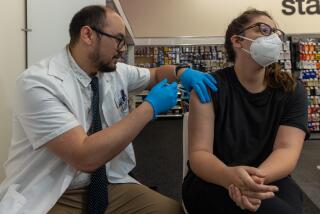Obesity puts swine flu sufferers at greater risk, study suggests
Obesity appears to be a risk factor on a par with pregnancy for developing complications from an infection with pandemic H1N1 influenza, according to the most comprehensive look yet at swine flu hospitalizations.
About a quarter of those hospitalizations have been for people who were morbidly obese, even though such people make up less than 5% of the population. That fivefold increase in risk is close to the sixfold increase observed in pregnant women, according to the report published today in the Journal of the American Medical Assn.
When the merely obese are included with the morbidly obese, they make up 34% of the American population. Yet they accounted for 58% of the hospitalizations in the study.
âIt makes intuitive sense,â said Dr. Thomas R. Frieden, director of the Centers for Disease Control and Prevention, who noted that obese people have a higher risk of many diseases and thus a lower life expectancy. âIt should be added as one of the underlying conditions.â
The CDC considers adults to be obese if their body mass index is 30 or above and morbidly obese if their BMI tops 40. A person who is 5 feet 8 would be obese if he or she weighs at least 197 pounds and morbidly obese if he or she weighs at least 262 pounds.
Researchers have seen anecdotal reports throughout the course of the pandemic that the obese might be at greater risk of complications from infection, but it has never been clear whether this was a result of obesity or of risk factors associated with obesity.
In the JAMA study, which analyzed data from all 1,088 swine-flu-related hospitalizations that occurred in California from the beginning of the outbreak this spring through Aug. 11, researchers from the state Department of Public Health identified 268 adults whose BMIs were known. Of those, 156 were obese, including 67 who were morbidly obese. Forty-six of those obese adults died, according to the study.
In addition, 19% of hospitalized swine flu patients between the ages of 2 and 17 were considered obese, with a BMI above the 95th percentile for their age. None of those patients died.
The researchers found that two-thirds of the obese patients had a health problem that was previously recognized as an underlying risk factor for swine flu. The most common were chronic lung disease, heart disease and diabetes.
But that still left one-third of obese patients without other risk factors, said Dr. Janice K. Louie, lead author of the study and chief of the state health departmentâs influenza and respiratory syndromes section.
There are many possible explanations.
Some of them are physiological. The lungs of obese patients are compressed because the abdomen presses up on the diaphragm. In addition, the chest wall is heavier, so itâs more difficult for the lungs to stay inflated.
Both of those factors make it difficult for blood and oxygen to travel throughout the lungs and fight off infection, said Dr. Lena Napolitano, chief of acute-care surgery at the University of Michigan Health System. She recently published a report in the CDCâs Morbidity and Mortality Weekly Report on 10 swine flu patients admitted to the intensive care unit there; of the 10, nine were obese, including seven who were morbidly obese.
The compromised immune system of obese people probably also plays a role, said Dr. David Heber, director of the Risk Factor Obesity Program at UCLAâs David Geffen School of Medicine. Scientists believe that people who are obese have a baseline level of inflammation that diminishes the bodyâs ability to fight diseases.
Studies of obese mice help explain why.
Researchers at the University of North Carolina in Chapel Hill found that 42% of obese mice died when infected with a human strain of flu, while the same virus killed only 5% of lean mice. The lungs of the obese mice failed to produce two crucial kinds of immune cells called cytokines that fight off viruses. There was also a decrease in natural killer cells and T-cells, two other components of the immune system, said Patricia Sheridan, a nutritional immunologist at UNC who worked on the study.
Those results raise questions about whether flu vaccines prompt enough of an immune response to offer any protection to obese people. UNC researchers are studying that, Sheridan said.
In addition to the findings on obesity, the JAMA study found that:
* More than a third of the patients reported nausea or vomiting, and a fifth reported diarrhea. Such gastrointestinal symptoms are observed in fewer than 5% of those hospitalized with seasonal flu.
* Rapid tests for influenza commonly used for initial screening gave false negatives 34% of the time, an unexpectedly high rate.
Since Aug. 11, nearly 3,000 more Californians have been hospitalized with swine flu and 131 have died, Louie said.







